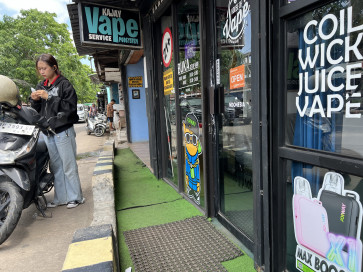Popular Reads
Top Results
Can't find what you're looking for?
View all search resultsPopular Reads
Top Results
Can't find what you're looking for?
View all search resultsCathedral museum counts on volunteers
The magnificent Jakarta Cathedral in Central Jakarta, with its 60-meter-tall twin towers, offers more than its beautiful facade and majestic decor
Change text size
Gift Premium Articles
to Anyone
T
he magnificent Jakarta Cathedral in Central Jakarta, with its 60-meter-tall twin towers, offers more than its beautiful facade and majestic decor.
As a national heritage site located close to the Istiqlal Mosque, the Protestant Immanuel Church, the National Monument and the Presidential Palace, the church is a silent witness of the country’s history.
And yet there is even more to the church than meets the eye.
Not many people know that the church has kept in its bosom the relics of Catholicism, some of them from as early as the 17th century.
The cathedral’s museum, home to many of these relics, was built in 1991 on the second floor of the church.
It is open to the public every Monday, Wednesday and Friday from 10 a.m. to 12 noon. No entry fee is required and each visitor will receive a leaflet about the museum’s collections.
There are three to four guides in charge each day, ready to help visitors enjoy the upper floor — the former home of the church’s choir. A total of 13 people, including seven guides, are responsible for taking care of the museum.
Susyana Suwadie, the museum’s director, said recently that the museum’s workers were volunteers.
“We don’t get salaries for taking care of this museum. We consider it a form of service to the church,”
she said.
Susyana said that the volunteers came from various backgrounds. “Some of us have day jobs, while some other are housewives,” she said.
The limited number of volunteers, Susyana said, had forced the museum to make adjustment here and there, including shortening visiting hours.
The volunteers have done their best to preserve the collections, some of which were already fragile due to age.
“Many of the relics are very old, such as this clock made in the 17th century. It’s not an easy job since we don’t have an expert who can really know how to fix the clock if it’s broken. But we do the best that we can,” Susyana said.
Unlike the small museum, the church itself has access to a wide array of resources thanks to its designation as a national heritage site. Curators from the National Museum regularly come to preserve church relics and paintings, while staffers from the National Archives take care of the church’s book and manuscript collections.
The museum is the home of around 400 items, including relics of Catholic rituals like silver grails, hats and robes of the archbishops and cardinals.
The museum also houses the mace that was used by Pope Paul VI when he visited Jakarta in 1970, and the grail used by Pope John Paul II when he came to the capital in 1989.
Visitors can also learn about the history of the Roman Catholic Church in Indonesia through a series of paintings and photographs. There are photos of the original building of the church, which was completed in 1901, and other historic buildings in Jakarta.
“The old pictures and paintings need special treatment. We have yet to provide the best treatment, but we try to keep the level of humidity inside the room stable,” she said.
Among the old collections, visitors may notice one relatively new work of art. The painting was made by Kusni Kasdut, a legendary thief who specialized in antiques. He converted to Catholicism and was baptized while on death row in Cipinang Penitentiary before his execution in 1980.
The painting of the Cathedral, which Kusni made of banana midribs while in prison, was donated to the church before his death.
Currently, the museum sees about 200 visitors each month. Most of them are churchgoers, although the museum attracts tourists as well.
According to Susyana, many of the visitors came after they found information about the museum from the cathedral’s website katedraljakarta.or.id.
“Some of our visitors are those who come to see the church and coincidentally learn about the museum on the second floor,” she said, adding that she hoped the museum would be more popular among the city’s residents.
Susyana said that the museum would host an open house to commemorate its 21st anniversary in April.
“We plan to hold the open house on April 29. We are still trying to gather more volunteers. Hopefully, we can open the museum every day,” she added.










